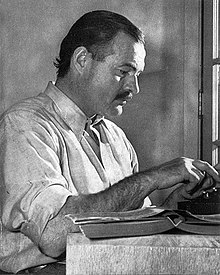Ernest Hemingway
| Ernest Hemingway | |
|---|---|

Ernest Hemingway working on his book For Whom the Bell Tolls at the Sun Valley Lodge, Idaho in December 1939
|
|
| Born |
July 21, 1899 Oak Park, Illinois, U.S. |
| Died | July 2, 1961 (aged 61) Ketchum, Idaho, U.S. |
| Notable awards | Pulitzer Prize for Fiction (1953) Nobel Prize in Literature (1954) |
| Spouses |
Elizabeth Hadley Richardson (m. 1921; div. 1927) Pauline Pfeiffer (m. 1927; div. 1940) Martha Gellhorn (m. 1940; div. 1945) Mary Welsh Hemingway (m. 1946; his death 1961) |
| Children | Jack, Patrick, Gregory |
Ernest Miller Hemingway (July 21, 1899 – July 2, 1961) was an American novelist, short story writer, and journalist. His economical and understated style had a strong influence on 20th-century fiction, while his life of adventure and his public image influenced later generations. Hemingway produced most of his work between the mid-1920s and the mid-1950s, and won the Nobel Prize in Literature in 1954. He published seven novels, six short story collections, and two non-fiction works. Additional works, including three novels, four short story collections, and three non-fiction works, were published posthumously. Many of his works are considered classics of American literature.
Hemingway was raised in Oak Park, Illinois. After high school, he reported for a few months for The Kansas City Star, before leaving for the Italian front to enlist with the World War I ambulance drivers. In 1918, he was seriously wounded and returned home. His wartime experiences formed the basis for his novel A Farewell to Arms (1929).
In 1921, he married Hadley Richardson, the first of his four wives. The couple moved to Paris, where he worked as a foreign correspondent and fell under the influence of the modernist writers and artists of the 1920s "Lost Generation" expatriate community. He published his debut novel, The Sun Also Rises, in 1926. After his 1927 divorce from Richardson, Hemingway married Pauline Pfeiffer; they divorced after he returned from the Spanish Civil War, where he had been a journalist, and after which he wrote For Whom the Bell Tolls (1940). Martha Gellhorn became his third wife in 1940; they separated when he met Mary Welsh in London during World War II. He was present at the Normandy landings and the liberation of Paris.
...
Wikipedia
